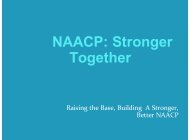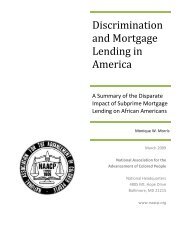TOOLKIT
TOOLKIT
TOOLKIT
Create successful ePaper yourself
Turn your PDF publications into a flip-book with our unique Google optimized e-Paper software.
What is Climate Justice?<br />
According to the Environmental Justice and Climate Change Initiative, climate justice is a “vision<br />
to dissolve and alleviate the unequal burdens created by climate change. As a form of<br />
environmental justice, climate justice is the fair treatment of all people and freedom from<br />
discrimination with the creation of policies and projects that address climate change and the<br />
systems that create climate change and perpetuate discrimination.”<br />
Many people are negatively affected by climate change, thus making it a human rights issue,<br />
especially for people of color, low-income and Indigenous communities. These vulnerable<br />
communities are the first to experience the negative impacts of climate change such as heatrelated<br />
illness and death, respiratory illness, infectious diseases, unaffordable rises in energy<br />
costs, and extreme natural disasters. Not only do they bear disproportionate burdens from<br />
climate change itself, but also from climate change drivers, like coal plants, and ill-designed<br />
policies meant to prevent climate change but tend to exclude those that need the most<br />
protection. Moreover, those who are most affected are least responsible for the greenhouse gas<br />
emissions that cause the problem–both nationally and globally.<br />
Climate injustice affects communities both locally and globally. In the U.S., a vast majority of<br />
low-income communities and communities of color are concentrated in urban centers in the<br />
Southern United States and along coastal regions–areas at high risk of flooding and major<br />
storms, and that have a history of substandard air quality. Additionally the use of antiquated<br />
forms of energy such as coal fired power plants and natural gas lead toxic contamination of the<br />
air, ground, and ground water – these energy sources are predominately placed in areas where<br />
vulnerable communities have settled. Climate Justice links human rights to development in<br />
order to achieve a human-centered approach, safeguarding the rights of the most vulnerable<br />
and sharing the burdens and benefits of climate change and its solutions equitably and fairly.<br />
Climate justice is informed by science, responds to science and acknowledges the need for<br />
equitable stewardship of the world’s resources.<br />
The Mary Robinson Foundation - Climate Justice (MRFCJ) notes that we should all share the<br />
benefits and burdens of climate change. In fact, the “benefits and burdens associated with<br />
climate change and its resolution must be fairly allocated. This involves acceptance of common<br />
but differentiated responsibilities and respective capabilities in relation to reduction of<br />
greenhouse gas emissions. Those who have most responsibility for greenhouse gas emissions<br />
and most capacity to act must cut emissions first.<br />
“In addition, those who have benefited and still benefit from emissions in the form of on-going<br />
economic development and increased wealth, mainly in industrialized countries, have an ethical<br />
obligation to share benefits with those who are today suffering from the effects of these<br />
emissions, mainly vulnerable people in developing countries. People in low income countries<br />
must have access to opportunities to adapt to the impacts of climate change and embrace low<br />
carbon development to avoid future environmental damage.”<br />
14 | P a g e








